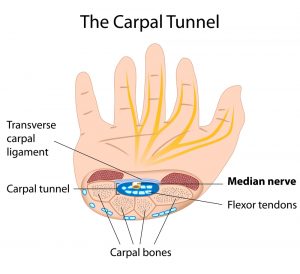The Wrist and Hand
Our wrist and hand physiotherapy covers highly complex areas of the body. The radius and ulna (forearm bones) meet the 1st row of 4 carpals of the hand this is known as the radio-carpal joint and can be considered the main wrist joint allowing movement up and down at the wrist. Between these two joint surfaces is an articular disc. There is also a joint between the distal ends of the radius and ulna that along with the elbow joint allows for rotation of the forearm.
To provide stability to the wrist joint, a thin capsule attaches between the radius, ulna and carpals, which also blends to a number of ligaments, again to provide stability. The most commonly injured ligament is the dorsal radio-carpal ligament, e.g. when falling onto an outstretched hand.
There are many muscles that act over the wrist and hands which can be split up into extrinsic or intrinsic muscles. The extrinsic muscle bellies are located on the forearm and are known as long flexors and extensors. The intrinsic muscles originate and insert within the hand itself, known as the thenar (thumb), hypothenar (little finger), interossei and lumbrical muscles.
The Hand
The human hand has 27 bones. There are 2 layers of 4 carpal bones in the hand, equalling 8 in total. The 1st row connect to the radius and ulna as above, this is where the majority of bony/ligament injuries occur, namely between the scaphoid and lunate bones.
The 1st and 2nd row of carpals are all connected together by ligaments. There are 5 metacarpals that are attached to the 2nd row of carpals and finally the 14 phalanges (split into proximal, middle or distal), commonly known as the finger bones. Again, all are connected by ligaments to provide structural stability.
The hand is innervated by 3 main motor nerves (those responsible for movement), known as the radius, ulna and median nerves.

Common Problems
Our wrist and hand physiotherapy treat a number of common problems and conditions, including:
- Carpal tunnel syndrome
- De-Quervains tenosynovitis
- Wrist tendinitis
- Ligament sprains
- Osteoarthritis
- Repetitive Stress Injury (RSI)
- Triangular fibrocartilage complex tears
- Trigger finger
- Dupuytrens contracture
- Carpal instabilities (Scapholunate dissociation)
- Finger dislocations
- Fractures: radius, ulna, Colles and reverse Colles, Boxers, Bennets, Rolando, carpals (scaphoid/lunate/hamate), fingers
- Post operatively:
- Ligament repairs
- Joint instabilities
Call Harpenden Physiotherapy Today
Give us a call on 01582 761448 or get in touch if you’d like to find out more about how our wrist and hand physiotherapy can help you with any pain or discomfort which you may be experiencing.








